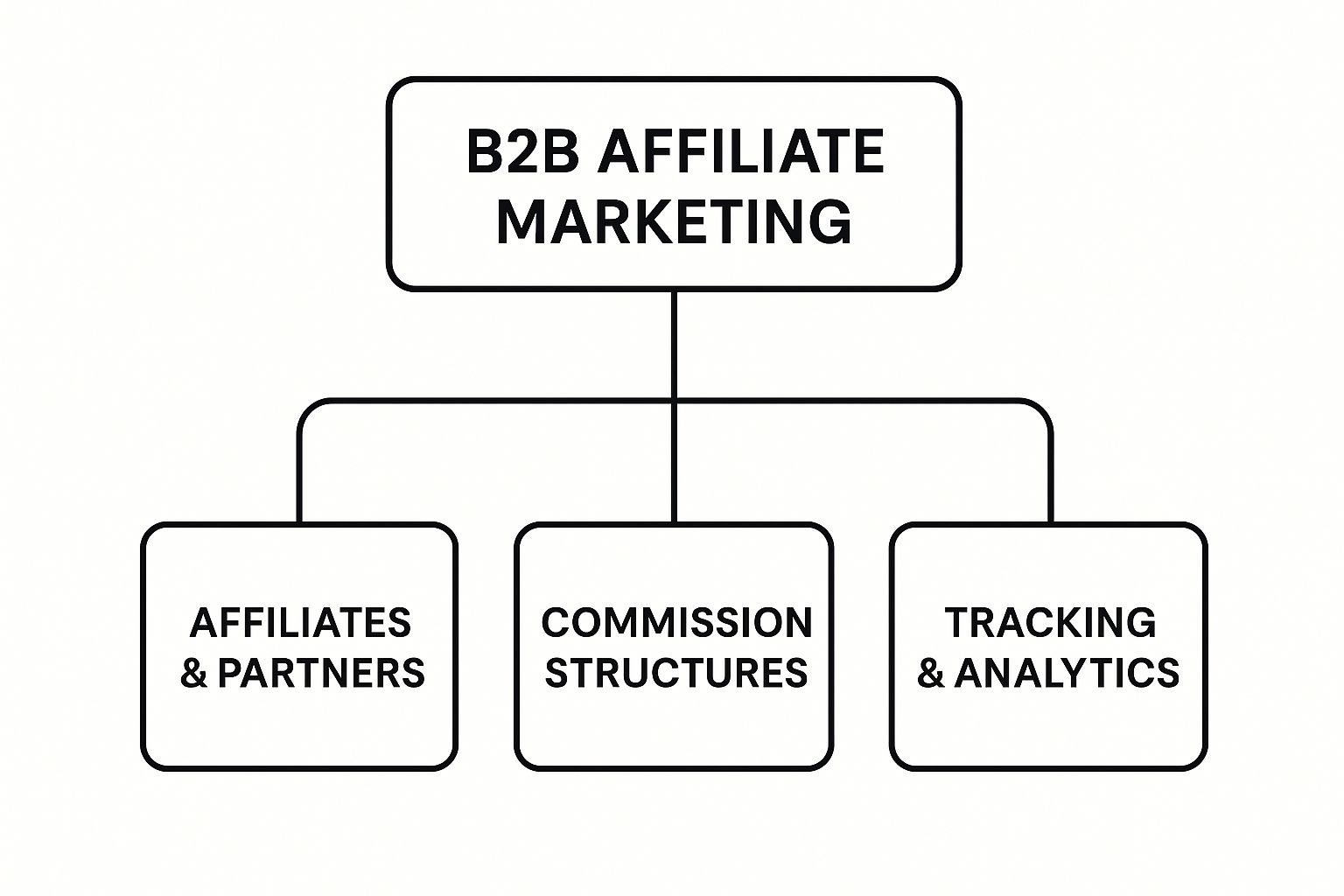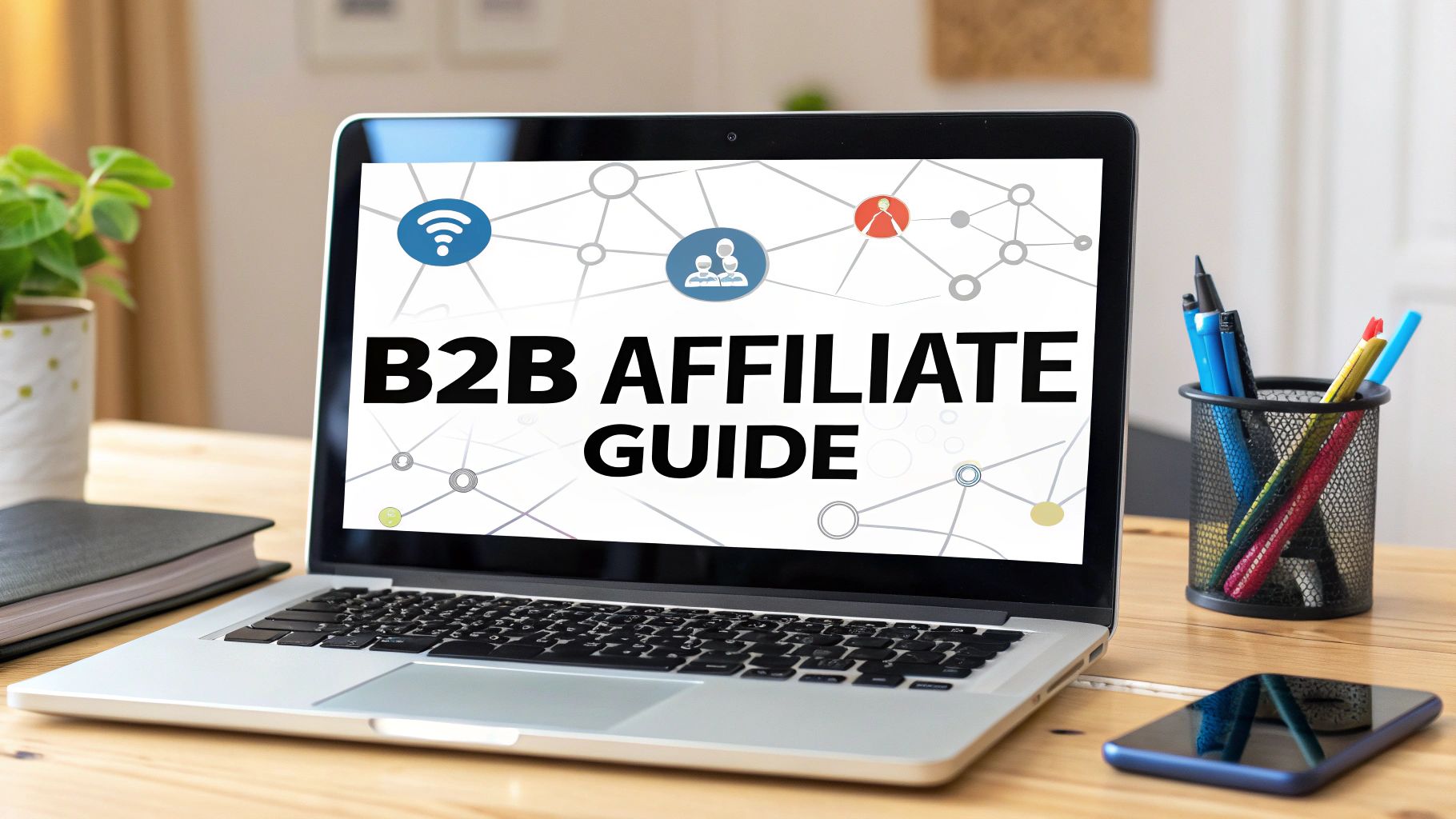Let’s cut through the jargon. B2B affiliate marketing is, at its core, a performance-based partnership. You team up with trusted industry voices—think expert consultants, respected bloggers, or even complementary tech companies—and they act as an extension of your sales force. The catch? You only pay them when their recommendation brings you a new customer or a qualified lead.
What Is B2B Affiliate Marketing
Think of it this way: instead of shouting into the void with traditional ads, you're building a network of credible advocates who are already talking to your ideal customers. It’s not about flashy banner ads or hunting for coupon codes. This is a strategic alliance built on genuine authority and shared success.
Where old-school advertising interrupts, B2B affiliate marketing persuades. Your partners aren't just faceless promoters; they are an integral part of your brand, speaking to niche audiences with the kind of authenticity money can't buy.
Beyond Clicks to Meaningful Connections
The real difference between B2B and B2C affiliate marketing comes down to the customer journey. B2C is often a game of volume. It deals with lower-cost products, impulse buys, and a quick, low-touch sales process. A TikTok influencer sharing a link to a new pair of sneakers is a perfect example.
B2B, on the other hand, is a different beast entirely. We're talking about complex products, much higher price points, and sales cycles that can stretch for months. No one buys a new enterprise CRM on a whim. It involves deep research, getting the entire team on board, and a significant financial commitment. That's why a smart B2B affiliate marketing program will always choose quality over quantity.
The goal isn’t to drive thousands of random clicks. It’s to attract a handful of highly qualified leads who’ve been warmed up and educated by a partner they already listen to. This shifts the affiliate from a simple traffic-driver into a crucial part of the customer's decision-making journey.
This infographic breaks down the core components that make a B2B affiliate program tick, from finding the right partners to setting up the payments.

As you can see, a successful program is a balancing act. It’s about finding partners who align with your brand, offering commissions that truly motivate them, and using solid analytics to track what's actually working.
To really nail down the differences, let's look at a side-by-side comparison.
B2B vs B2C Affiliate Marketing Key Differences
| Characteristic | B2B Affiliate Marketing | B2C Affiliate Marketing |
|---|---|---|
| Primary Goal | Generate high-quality, qualified leads | Drive a high volume of sales |
| Audience | Niche, professional, decision-makers | Broad, mass-market consumers |
| Sales Cycle | Long and complex (weeks to months) | Short and simple (minutes to days) |
| Product/Service | High-value, complex solutions (e.g., SaaS) | Lower-cost, simple products (e.g., apparel) |
| Commission Structure | High one-time fees, recurring revenue share | Small percentage of a single sale |
| Partner Type | Industry experts, consultants, publications | Influencers, coupon sites, review bloggers |
This table makes it clear: while they share a name, the strategy and execution couldn't be more different. B2B requires a deeper, more strategic approach to building relationships.
A Cornerstone of Sustainable Growth
This isn't some fringe tactic; it's quickly becoming a key pillar of modern customer acquisition. The market's growth is undeniable, with North America accounting for roughly 40% of the global affiliate marketing sector. The U.S. is the largest hub within that market, and spending is projected to climb toward $16 billion by 2028. If you want to dig deeper, these affiliate marketing statistics paint a very clear picture of the opportunity.
Because B2B focuses on higher-value deals, the commission structures look fundamentally different, too. Instead of a tiny, one-off payout, B2B affiliates often earn commissions that are much more significant. These can include:
- High One-Time Payouts: A large, flat fee for each new customer, which makes sense given the high lifetime value of that client.
- Recurring Revenue Share: A percentage of the subscription fee for as long as the referred customer stays with you. This is a huge favorite in the SaaS world.
- Tiered Commissions: Payouts that get bigger as the affiliate brings in more sales, rewarding your top performers and encouraging them to stick around.
This kind of model gives affiliates a powerful reason to not just promote your product, but to truly advocate for it. They succeed only when you succeed, turning the relationship into a true partnership for long-term, sustainable growth.
The Strategic Benefits of B2B Affiliate Programs

A great B2B affiliate program does more than just boost sales. It's a strategic tool that can seriously de-risk your marketing budget while elevating your brand's reputation in a noisy marketplace.
The real magic is in its pay-for-performance model. Forget traditional advertising where you sink money into impressions or clicks with your fingers crossed. With affiliate marketing, you only pay a commission after a deal closes. This makes your customer acquisition cost (CAC) completely predictable and easy to manage.
Highly Cost-Effective Customer Acquisition
Think about it this way: what if you could hire an entire sales force that only gets paid when they bring in revenue? That’s exactly what a B2B affiliate program offers. This approach drastically lowers the financial risk of scaling your marketing or breaking into new territories.
Every single dollar you spend is directly tied to a new customer, creating an incredibly efficient growth machine. This is a game-changer for SaaS companies and startups where every budget line item is under scrutiny. If you're looking for more ways to make your marketing dollars work harder, check out these strategies to improve marketing ROI.
By shifting the financial risk onto your partners' performance, you can allocate your budget with confidence. You know it’s being spent to acquire actual customers, not just fleeting interest.
This model doesn't just protect your budget; it ensures your marketing spend is always productive. You're essentially building a self-funding growth system that allows for sustainable expansion without the eye-watering upfront costs of most marketing campaigns.
Accessing New Markets and Audiences
One of the biggest perks of B2B affiliate marketing is gaining instant access to new, highly relevant markets. Your affiliates aren't just random promoters; they are established authorities with loyal audiences who hang on their every word.
When a respected industry blogger, a trusted consultant, or a complementary tech company recommends your product, they’re giving you their seal of approval. It’s a warm introduction to potential customers you could never reach on your own. These partnerships are your bridge to:
- Niche Communities: Connect with specific professional circles that desperately need what you offer.
- Geographical Markets: Expand into new countries by teaming up with local experts who know the culture.
- Adjacent Industries: Tap into related sectors where your product could be a perfect fit.
This lets you scale your reach far beyond what your in-house team can manage, using the built-in trust of your partners to grow your customer base.
Enhancing Brand Authority and Trust
In the B2B world, trust is the ultimate currency. Decision-makers lean heavily on social proof and expert opinions before they ever sign a contract. Your affiliate program is a powerful engine for building that third-party validation.
When influential figures in your industry are willing to put their reputation on the line to recommend you, it sends a clear message: your solution is credible and effective. Frankly, that kind of endorsement is worth more than any ad campaign you could run.
As more and more affiliates advocate for your brand, you create a powerful network effect that cements your status as an industry leader. This foundation of trust shortens the sales cycle because leads show up already convinced and ready to talk business. To get the most out of these partnerships, you'll want to share proven tactics, like these powerful affiliate marketing strategies for SaaS.
How to Measure B2B Affiliate Success
 To figure out if your b2b affiliate marketing program is actually working, you have to look beyond the surface-level numbers. Sure, seeing a lot of clicks and impressions might feel good, but those metrics don't actually pay the bills. In the B2B world, success is all about how well your partners drive real, tangible results for your business.
To figure out if your b2b affiliate marketing program is actually working, you have to look beyond the surface-level numbers. Sure, seeing a lot of clicks and impressions might feel good, but those metrics don't actually pay the bills. In the B2B world, success is all about how well your partners drive real, tangible results for your business.
Think of it like being a restaurant critic. You wouldn't judge a chef on how many people walked through the door; you'd focus on how many diners loved the food, left great reviews, and became regulars. It's the same with your affiliate program. Its health hinges on metrics that show genuine revenue and growth, not just fleeting interest.
Core Metrics for Revenue Health
Vanity metrics can be dangerously misleading. A huge spike in traffic from an affiliate is completely useless if none of those visitors ever sign up and become paying customers. To get a real sense of performance, you need a dashboard that focuses on the data that truly impacts your bottom line.
These are the metrics you should build your entire analysis around:
- Customer Acquisition Cost (CAC) from Affiliates: This is the ultimate test of your program's efficiency. To find it, just divide your total affiliate payouts and program costs by the number of new customers you gained from that channel in a specific period. A low CAC is a clear sign you're acquiring customers profitably.
- Customer Lifetime Value (CLV) from Affiliates: This metric reveals the total revenue you can expect from a customer brought in by a partner. When you track CLV by affiliate, you can quickly spot which partners are sending you your most valuable, long-term customers—not just one-and-done buyers.
- Lead-to-Customer Conversion Rate: What percentage of leads from an affiliate actually convert into paying customers? A high conversion rate is one of the strongest indicators that an affiliate’s audience is a perfect fit for what you're selling.
Keeping a close eye on these three KPIs gives you a powerful, revenue-focused view of your program. It helps you move past the simple question of "who sent the most clicks?" to the much more important one: "who is delivering our most profitable customers?"
Uncovering the Full Impact
Of course, not every affiliate interaction leads to a direct sale, especially in B2B. Purchase decisions are often complex, involving multiple touchpoints over weeks or even months. This is where you need to take a more nuanced look at performance.
The real power of B2B affiliate marketing often lies in its influence across the entire sales funnel. A prospect might discover your brand through an affiliate's blog post, later see a social media ad, and finally convert through a direct visit. Attributing the sale solely to the last touchpoint ignores the affiliate's crucial role in starting that journey.
To capture this bigger picture, start tracking affiliate-influenced revenue. This metric includes any deal where an affiliate was involved at any stage of the buyer's journey, not just the final click. It helps demonstrate the true value your partners bring by building awareness and trust long before a sale is ever made.
For a deeper dive into quantifying marketing efforts, exploring an article on measuring return on investment (ROI) in other channels can provide some great insights you can apply to your own program. Understanding these principles helps you build a more complete and convincing case for your program's value.
By combining direct-response metrics like CAC and CLV with broader influence-based metrics, you get the full story. This data-driven approach gives you the confidence to prove your program's ROI, optimize your partnerships, and build a sustainable engine for long-term growth.
Building Your B2B Affiliate Program
Alright, so you’re sold on the "why." Now let’s get into the "how." Putting together a successful B2B affiliate marketing program isn't about just throwing up a sign-up page and hoping for the best. It's a deliberate, strategic process. This is about carefully building a system that attracts, motivates, and supports the right kind of partners for your brand.
Think of yourself as a general manager building a championship sports team. You wouldn't just recruit any player who can run; you'd look for specific skills that fit your strategy. You also wouldn't offer contracts that fail to inspire top performance. The same exact logic applies here. Your first job is to figure out who your ideal partners are and what it will take to make them genuinely want to champion your product.
Identifying Your Ideal Affiliate Partners
Not all affiliates are created equal, and this is especially true in the B2B world where trust and genuine expertise are everything. The success of your entire program really boils down to recruiting partners whose audience aligns perfectly with your ideal customer profile.
Let's break down the key players you should be looking for:
- Industry Bloggers and Content Creators: These are the established thought leaders already producing high-value content for your target market. They've built trust and can weave your product into their articles, videos, or podcasts in a way that feels natural, not forced.
- Consultants and Coaches: Professionals who advise other businesses are in a perfect spot to recommend tools they truly believe in. Their endorsement carries a ton of weight because their professional reputation is on the line with every recommendation.
- Integration Partners: Think other tech companies whose products complement yours. A partnership here is a win-win. They can recommend your solution to their customer base as an add-on that makes their own tool even better.
- Review Sites and Publications: Niche B2B software review sites serve an audience that is actively looking for solutions right now. Getting featured on these platforms puts you directly in front of buyers at the most critical point in their journey.
Vetting is absolutely crucial. Look for partners with real engagement and a reputation for giving authentic advice, not just those with a massive follower count. A smaller, highly-engaged audience is infinitely more valuable than a huge, indifferent one.
Designing a Motivating Commission Structure
Once you know who you want to recruit, you need to give them a compelling reason to sign up. Your commission structure is the engine of your affiliate program. If it’s poorly designed, the whole thing will sputter and stall.
A one-size-fits-all approach is almost always a mistake. The most effective programs often use a tiered or flexible model to motivate different kinds of partners and to properly reward the top performers who go above and beyond.
The goal is to create a true win-win scenario. The affiliate's compensation should be directly tied to the value they bring to your business. This alignment transforms a simple transaction into a powerful, long-term strategic partnership.
Here are a few proven commission models that work well in B2B:
- Recurring Commissions: For SaaS, this is the gold standard. You offer a percentage (say, 20-30%) of the subscription fee for a set period, like the first year, or even for the customer's lifetime. This model encourages affiliates to send you high-quality, loyal customers who stick around.
- Tiered Commissions: This structure rewards high performance by bumping up the commission rate as an affiliate hits specific sales milestones. For instance, they might earn 20% on their first 10 sales but jump to 30% on every sale after that. It’s a powerful motivator.
- One-Time Payouts: Sometimes called a "bounty," this is a high, flat-rate payment for each new customer. It's simpler to manage, but it may not incentivize affiliates to focus on customer loyalty as much as a recurring model does.
The Role of Technology and Automation
Trying to manually track clicks, conversions, and payouts in a spreadsheet is a recipe for disaster. It’s a slow, error-prone nightmare that will quickly destroy the trust you're trying to build with your partners. This is where dedicated affiliate management software is no longer a nice-to-have, but an absolute must.
A robust platform takes care of all the core functions of your program, making it professional and scalable from day one. You should look for tools that can handle:
- Automated Tracking: Reliably attributing every single sale to the correct affiliate.
- Real-Time Dashboards: Giving both you and your partners a clear view of performance metrics.
- Seamless Payouts: Handling commission payments accurately and on time, every time.
- Asset Management: A central hub where partners can easily grab your logos, banners, and pre-written swipe copy.
Using the right technology is the foundation for effective affiliate program management and building partnerships that pay real dividends. A major trend to watch is the rise of AI; by 2025, it's expected to influence over 50% of digital marketing strategies, including affiliate marketing, by optimizing campaigns and improving how we target audiences. As you can see from these impactful affiliate marketing statistics, integrating AI can help you better reach professional audiences and navigate their complex buying journeys.
Platforms like our own Refgrow are built to embed this entire system directly into your SaaS product. This creates a native, frictionless experience for both your internal team and your affiliate partners, ensuring your program is built on a solid foundation that’s ready to scale with you.
Common B2B Affiliate Marketing Mistakes to Avoid

Starting a B2B affiliate marketing program is an exciting step, but it’s easy to get tripped up by a few common mistakes. Knowing what these pitfalls are ahead of time can be the difference between a program that drives real growth and one that just drains your budget and energy.
Think of it less like flipping a switch and more like tending a garden. You can't just toss some seeds on the ground and expect a harvest. You need the right soil, proper care, and an eye for potential problems. Without that foresight, you’ll end up with more weeds than revenue.
Partnering with the Wrong People
This is, without a doubt, the number one mistake I see companies make. They get star-struck by an affiliate’s massive audience size and completely overlook whether that audience is actually a good fit.
In the B2B world, audience alignment is everything. A partner with a small, niche following of decision-makers in your industry is infinitely more valuable than a huge influencer with a general audience. If their followers aren't your ideal customers, you're just paying for clicks that go nowhere. It’s like setting up a booth for enterprise software at a comic book convention—you’re in the wrong place.
Before you even think about an agreement, get answers to these questions:
- Does their content speak directly to the problems our product solves?
- Are they seen as a credible, trustworthy expert in our space?
- Is their audience engaged, asking questions, and listening to their advice?
A "no" here is a dealbreaker. Taking the time to properly vet your partners is the single best investment you can make in your program.
Providing Poor Affiliate Support
So you've found the perfect partners. Great! Now, don't just throw them a link and wish them luck. Affiliates aren't your employees, but they are an extension of your marketing team. If you leave them to fend for themselves, their initial excitement will quickly fizzle out.
Imagine showing up for your first day at a new job, only to find an empty desk with no computer, no instructions, and no one to talk to. You’d feel lost and unmotivated, right? That’s exactly how your affiliates feel when they don't get the support they need. They'll simply move on to a program that does.
Your affiliates are your partners in growth. Equipping them for success is equipping your business for success. Providing robust support isn’t a cost; it’s an investment in a high-performing sales channel.
Good support means giving them everything they need to win: high-quality creative, regular product updates, and a dedicated contact person for their questions. Using a platform like Refgrow can streamline this by giving partners a central hub for all the assets and information they need.
Creating Confusing Commission Structures
The commission structure is the engine of your affiliate program. If it's confusing, convoluted, or feels unfair, you'll kill motivation and breed distrust before you even get started. Your partners need to see a crystal-clear path from their effort to their earnings.
Ambiguity is your enemy. A complex structure with murky rules, hidden clauses, or delayed payouts makes affiliates suspicious. It feels like you’re trying to pull a fast one, which completely undermines the relationship and discourages them from giving you their best work.
To sidestep this common blunder, make sure your commission structure is:
- Simple: Anyone can understand it at a glance.
- Fair: It rewards partners for the genuine value they create.
- Transparent: Payments are clearly defined and tracked in real-time.
A clean, predictable model—like a recurring commission on every subscription payment—builds trust and keeps everyone aligned. When your partners are confident in the system, they’ll put their full energy into promoting your business, turning your affiliate program into a growth machine you can count on.
Integrating a Native Referral Program for SaaS
When it comes to SaaS, your happiest customers are your best marketers. So why send them to a clunky, third-party portal to manage referrals? The most effective approach is to embed your B2B affiliate marketing program directly into your own product. This creates a native referral experience that feels like a natural part of your software, not a tacked-on extra.
A native program just makes sense. It gets rid of all the friction. When the entire referral system lives inside your app, users can grab their link, see who's signed up, and check their rewards without ever leaving their dashboard. That seamless experience is what turns casual users into enthusiastic promoters, building a growth engine powered by your own community.
Building a Frictionless Experience
The whole idea is to make sharing your product as easy as using it. A well-designed native program automates everything—from generating links to managing payouts—so your users can become advocates in just a couple of clicks. This is exactly where a tool like our own Refgrow comes into play.
Here’s a great example of what a clean, embedded dashboard looks like right inside a SaaS product.
As you can see, the user gets their unique link, tracks clicks and signups, and sees their earnings, all within an interface they already know. It’s intuitive and encourages people to get started right away, turning customer advocacy into a scalable, automated channel.
The Power of Customer Advocacy
When you make your customers your primary affiliates, you're tapping into a level of trust that traditional marketing just can't buy. Think about it—a recommendation from a peer who actually uses and loves a product is incredibly powerful. It closes deals faster and brings in leads who are already sold on your value.
Learning from businesses that do this well is a great starting point. Exploring different client advocacy strategies can give you some fantastic ideas for building out your own initiatives. These examples really drive home the impact of turning happy customers into your most vocal marketing team.
By integrating your referral program natively, you're not just getting new customers—you're deepening the relationship with your current ones. You’re rewarding their loyalty and giving them a real stake in your success, which creates a powerful growth loop.
Here are the key steps to get a native program up and running:
- Design an Intuitive Interface: Your referral dashboard needs to be clean, simple, and feel like it belongs in your product. Users should immediately know how to find their link and check their progress.
- Automate Link Generation and Tracking: Every user should instantly get a unique, shareable referral link. The system must track clicks, signups, and conversions accurately and in real-time.
- Streamline Payouts: No one wants to deal with complicated commission spreadsheets. Whether you offer one-time rewards or recurring payouts, the system should handle all the calculations and payments with little to no manual work.
Embedding a referral system like this does more than just find new customers; it transforms your product into a platform for shared growth. You'll lower your acquisition costs while simultaneously boosting user engagement and loyalty.
Answering Your Top B2B Affiliate Marketing Questions
Diving into the world of B2B affiliate marketing can feel like exploring new territory. It's only natural to have a few questions. Let's tackle some of the most common ones we hear from SaaS teams just like yours.
How Long Does It Really Take to See Results?
Let's set the right expectations from the start: B2B affiliate marketing is a marathon, not a sprint. While a B2C campaign might see a quick pop, the B2B world moves differently. With longer sales cycles and much higher stakes, you should realistically plan to see consistent, meaningful revenue within three to six months.
Think of this initial phase as laying the foundation. You're not just flipping a switch; you're recruiting the right partners, building genuine relationships, and giving them the time to weave your product into their content in a way that feels natural. The goal here is a sustainable, long-term revenue channel, not a flash in the pan.
Patience in the first few months is an investment that pays off handsomely. A well-built program evolves into a predictable powerhouse for high-quality leads, eventually outperforming the short-lived wins from other channels.
What’s the Best Commission Structure for B2B SaaS?
For SaaS companies, the gold standard is the recurring commission. This model is a win-win because it aligns your partners' goals perfectly with your own—they’re incentivized to bring in loyal, high-value customers who stick around.
A common and effective rate is a 20-30% recurring commission for the first year of a customer's subscription. While some companies might offer a one-time "bounty" payment per signup, the recurring model is far more powerful. It motivates your affiliates to find customers who are the best fit, not just the easiest to convert.
Can I Just Run a Program With Spreadsheets?
Technically, you could try to manage a tiny program with a spreadsheet. But honestly, it's a recipe for disaster. This manual approach is a nightmare to scale, riddled with potential for errors, and the fastest way to lose the trust of your partners.
Investing in dedicated affiliate management software isn't a luxury; it's essential for building a program that partners will take seriously. The right platform handles the heavy lifting, ensuring your program is credible and runs smoothly.
- Accurate Tracking: Every click, lead, and sale is attributed correctly. No disputes, no lost commissions.
- Transparent Reporting: You and your partners get a clear, real-time view of performance.
- Seamless Payments: Commissions are paid out on time, every time, without you having to think about it.
Ready to turn your most passionate users into your best growth channel? With Refgrow, you can build a native affiliate and referral program right inside your own SaaS product. Launch in minutes, automate your partnerships, and watch your revenue scale. Get started with Refgrow today.

